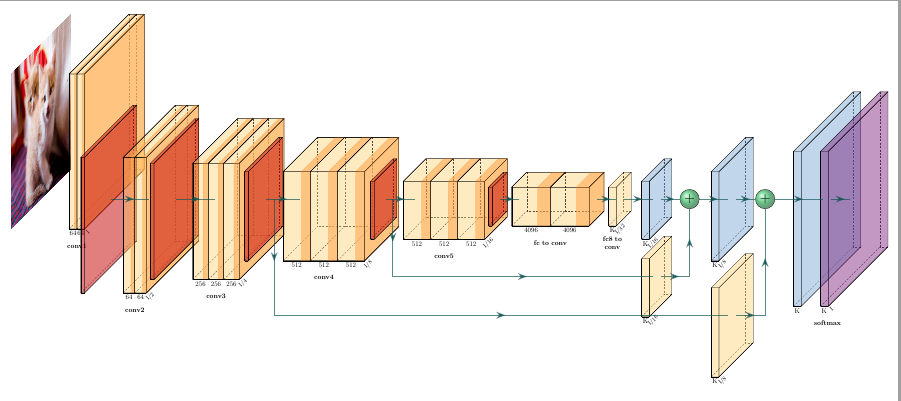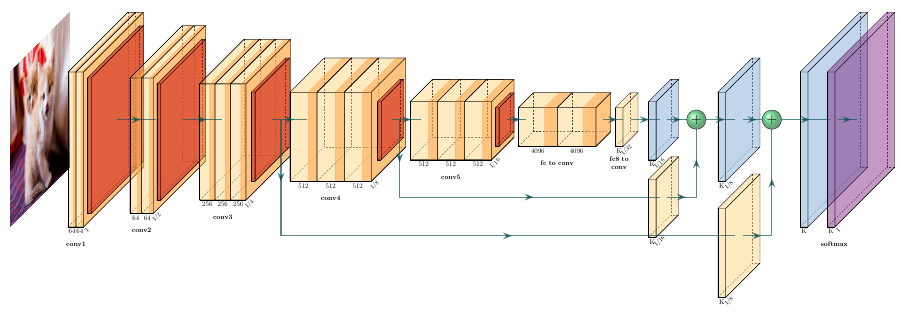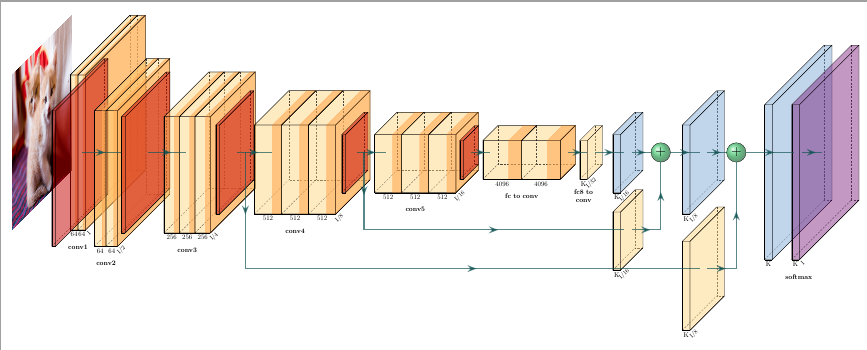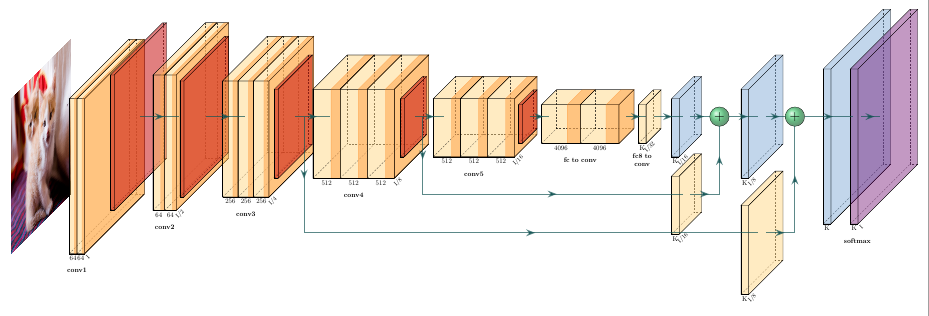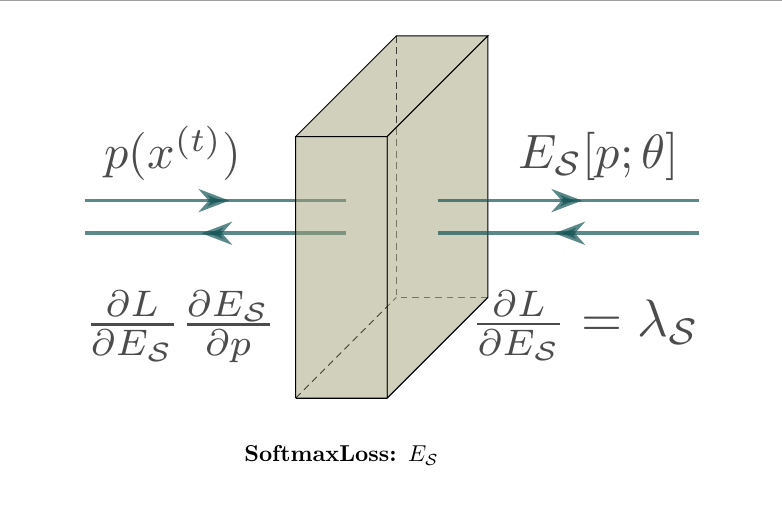1
2
3
4
5
6
7
8
9
10
11
12
13
14
15
16
17
18
19
20
21
22
23
24
25
26
27
28
29
30
31
32
33
34
35
36
37
38
39
40
41
42
43
44
45
46
47
48
49
50
51
52
53
54
55
56
57
58
59
60
61
62
63
64
65
66
67
68
69
70
71
72
73
74
75
76
77
78
79
80
81
82
83
84
85
86
87
88
89
90
91
92
93
94
95
96
97
98
99
100
101
102
103
104
105
106
107
108
109
110
111
112
113
114
115
116
117
118
119
120
121
122
123
124
125
126
127
128
129
130
131
132
133
134
135
136
137
138
139
140
141
142
| \documentclass[border=15pt, multi, tikz]{standalone}
\usepackage{import}
\subimport{../../layers/}{init}
\usetikzlibrary{positioning}
\usetikzlibrary{3d}
\def\ConvColor{rgb:yellow,5;red,2.5;white,5}
\def\ConvReluColor{rgb:yellow,5;red,5;white,5}
\def\PoolColor{rgb:red,1;black,0.3}
\def\DcnvColor{rgb:blue,5;green,2.5;white,5}
\def\SoftmaxColor{rgb:magenta,5;black,7}
\def\SumColor{rgb:blue,5;green,15}
\begin{document}
\begin{tikzpicture}
\tikzstyle{connection}=[ultra thick,every node/.style={sloped,allow upside down},draw=\edgecolor,opacity=0.7]
\node[canvas is zy plane at x=0] (temp) at (-3,0,0) {\includegraphics[width=8cm,height=8cm]{cats.jpg}};
\pic[shift={(0,0,0)}] at (0,0,0) {RightBandedBox={name=cr1,caption=conv1,
xlabel={{"64","64"}},zlabel=I,fill=\ConvColor,bandfill=\ConvReluColor,
height=40,width={2,2},depth=40}};
\pic[shift={(0,0,0)}] at (cr1-east) {Box={name=p1,
fill=\PoolColor,opacity=0.5,height=35,width=1,depth=35}};
\pic[shift={(2,0,0)}] at (p1-east) {RightBandedBox={name=cr2,caption=conv2,
xlabel={{"64","64"}},zlabel=I/2,fill=\ConvColor,bandfill=\ConvReluColor,
height=35,width={3,3},depth=35}};
\pic[shift={(0,0,0)}] at (cr2-east) {Box={name=p2,
fill=\PoolColor,opacity=0.5,height=30,width=1,depth=30}};
\pic[shift={(2,0,0)}] at (p2-east) {RightBandedBox={name=cr3,caption=conv3,
xlabel={{"256","256","256"}},zlabel=I/4,fill=\ConvColor,bandfill=\ConvReluColor,
height=30,width={4,4,4},depth=30}};
\pic[shift={(0,0,0)}] at (cr3-east) {Box={name=p3,
fill=\PoolColor,opacity=0.5,height=23,width=1,depth=23}};
\pic[shift={(1.8,0,0)}] at (p3-east) {RightBandedBox={name=cr4,caption=conv4,
xlabel={{"512","512","512"}},zlabel=I/8,fill=\ConvColor,bandfill=\ConvReluColor,
height=23,width={7,7,7},depth=23}};
\pic[shift={(0,0,0)}] at (cr4-east) {Box={name=p4,
fill=\PoolColor,opacity=0.5,height=15,width=1,depth=15}};
\pic[shift={(1.5,0,0)}] at (p4-east) {RightBandedBox={name=cr5,caption=conv5,
xlabel={{"512","512","512"}},zlabel=I/16,fill=\ConvColor,bandfill=\ConvReluColor,
height=15,width={7,7,7},depth=15}};
\pic[shift={(0,0,0)}] at (cr5-east) {Box={name=p5,
fill=\PoolColor,opacity=0.5,height=10,width=1,depth=10}};
\pic[shift={(1,0,0)}] at (p5-east) {RightBandedBox={name=cr6_7,caption=fc to conv,
xlabel={{"4096","4096"}},fill=\ConvColor,bandfill=\ConvReluColor,
height=10,width={10,10},depth=10}};
\pic[shift={(1,0,0)}] at (cr6_7-east) {Box={name=score32,caption=fc8 to conv,
xlabel={{"K","dummy"}},fill=\ConvColor,
height=10,width=2,depth=10,zlabel=I/32}};
\pic[shift={(1.5,0,0)}] at (score32-east) {Box={name=d32,
xlabel={{"K","dummy"}},fill=\DcnvColor,
height=15,width=2,depth=15,zlabel=I/16}};
\pic[shift={(0,-4,0)}] at (d32-west) {Box={name=score16,
xlabel={{"K","dummy"}},fill=\ConvColor,
height=15,width=2,depth=15,zlabel=I/16}};
\pic[shift={(1.5,0,0)}] at (d32-east) {Ball={name=elt1,
fill=\SumColor,opacity=0.6,
radius=2.5,logo=$+$}};
\pic[shift={(1.5,0,0)}] at (elt1-east) {Box={name=d16,
xlabel={{"K","dummy"}},fill=\DcnvColor,
height=23,width=2,depth=23,zlabel=I/8}};
\pic[shift={(0,-6,0)}] at (d16-west) {Box={name=score8,
xlabel={{"K","dummy"}},fill=\ConvColor,
height=23,width=2,depth=23,zlabel=I/8}};
\pic[shift={(1.5,0,0)}] at (d16-east) {Ball={name=elt2,
fill=\SumColor,opacity=0.6,
radius=2.5,logo=$+$}};
\pic[shift={(2.5,0,0)}] at (elt2-east) {Box={name=d8,
xlabel={{"K","dummy"}},fill=\DcnvColor,
height=40,width=2,depth=40}};
\pic[shift={(1,0,0)}] at (d8-east) {Box={name=softmax,caption=softmax,
xlabel={{"K","dummy"}},fill=\SoftmaxColor,
height=40,width=2,depth=40,zlabel=I}};
\draw [connection] (p1-east) -- node {\midarrow} (cr2-west);
\draw [connection] (p2-east) -- node {\midarrow} (cr3-west);
\draw [connection] (p3-east) -- node {\midarrow} (cr4-west);
\draw [connection] (p4-east) -- node {\midarrow} (cr5-west);
\draw [connection] (p5-east) -- node {\midarrow} (cr6_7-west);
\draw [connection] (cr6_7-east) -- node {\midarrow} (score32-west);
\draw [connection] (score32-east) -- node {\midarrow} (d32-west);
\path (p4-east) -- (cr5-west) coordinate[pos=0.25] (between4_5) ;
\draw [connection] (between4_5) -- node {\midarrow} (score16-west-|between4_5) -- node {\midarrow} (score16-west);
\draw [connection] (d32-east) -- node {\midarrow} (elt1-west);
\draw [connection] (score16-east) -- node {\midarrow} (score16-east -| elt1-south) -- node {\midarrow} (elt1-south);
\draw [connection] (elt1-east) -- node {\midarrow} (d16-west);
\path (p3-east) -- (cr4-west) coordinate[pos=0.25] (between3_4) ;
\draw [connection] (between3_4) -- node {\midarrow} (score8-west-|between3_4) -- node {\midarrow} (score8-west);
\draw [connection] (d16-east) -- node {\midarrow} (elt2-west);
\draw [connection] (score8-east) -- node {\midarrow} (score8-east -| elt2-south)-- node {\midarrow} (elt2-south);
\draw [connection] (elt2-east) -- node {\midarrow} (d8-west);
\draw [connection] (d8-east) -- node{\midarrow} (softmax-west);
\end{tikzpicture}
\end{document}\grid
|

